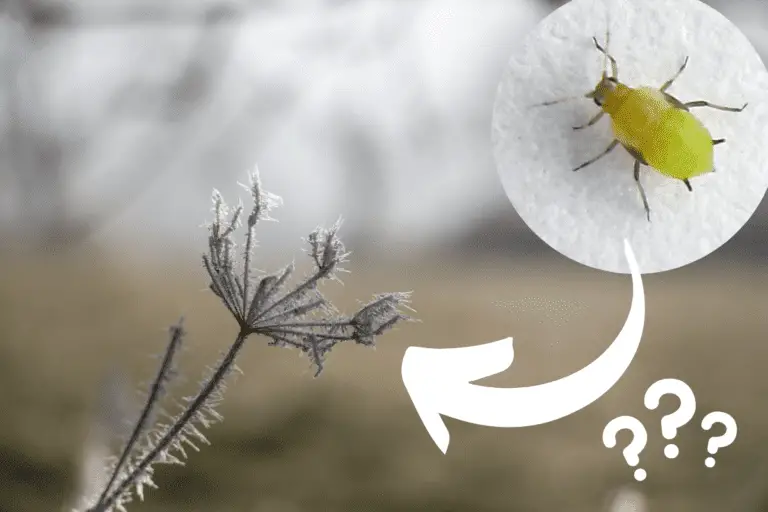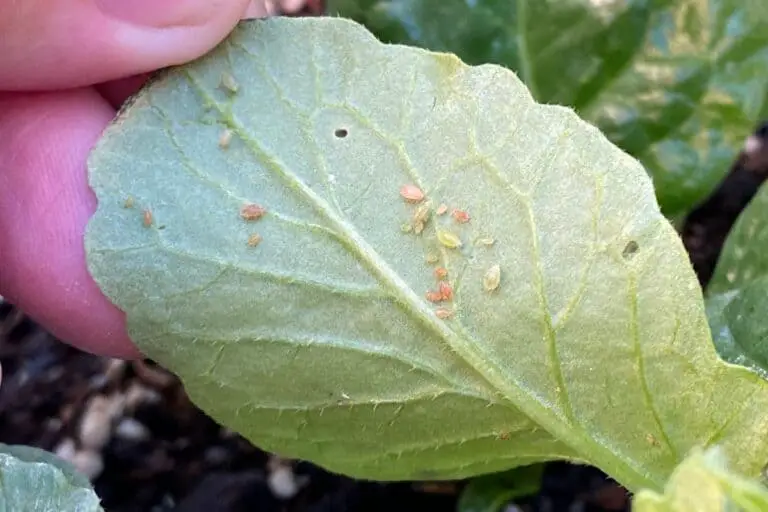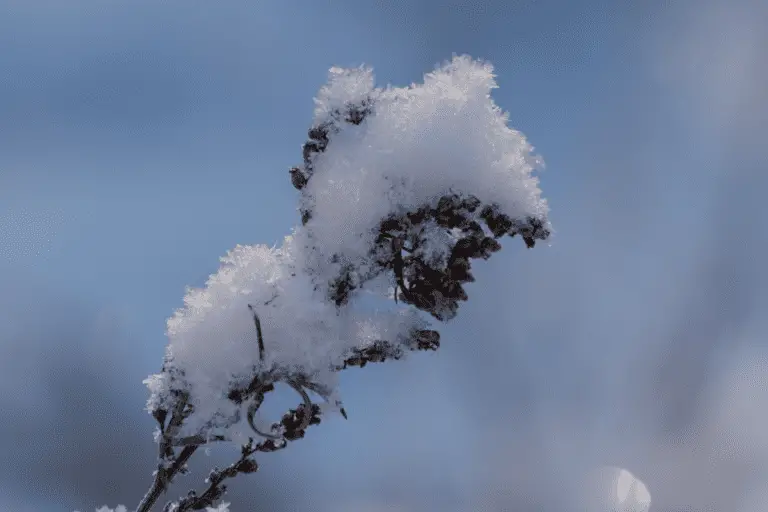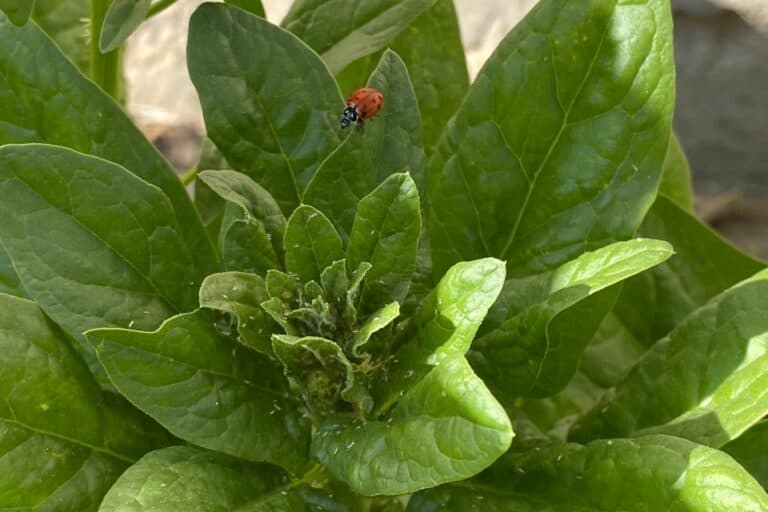11 Destructive Ways That Aphids Harm Plants
If you’ve been gardening for any amount of time, you’ve probably heard that aphids are bad news.
But have you ever wondered how exactly aphids will harm your plants? Or what aphid damage looks like?
Aphids harm plants by draining them of nutrients, causing yellowing or discolored foliage as well as plant decay and death. Aphids also spread plant diseases, increase the likelihood of fungal growth, damage developing fruit, attract unwanted ants, and infect plants with gall-forming toxins.
Unfortunately, this isn’t even a complete list of the damage that aphids can do if they arrive on your property.
I’ll discuss the details below–and give you several important tips and tricks for stopping aphids once you notice them among your garden plants–but here’s a quick overview of the damage that aphids can do:
- Rob Plants of Vital Nutrients
- Spread Plant Diseases
- Harm Developing Fruit
- Destroy Young Seedlings
- Increase the Risk of Fungal Diseases
- Inject Toxins Into Plants
- Cause Galls to Form on Plants
- Attract Insect-Killing Ants
- Multiply Exponentially
- Produce Flying Aphids
- Prepare for Future Infestations
In other words, an aphid infestation is no minor matter.
But you can stop them quickly if you know what to look for, spot infestations in their earliest stages, and react quickly to keep these bugs from reproducing.
With that in mind, let’s take a more detailed look at the list of damage that aphids can do so that you can understand how these pests work and how to best stop them once you see them among your plants.
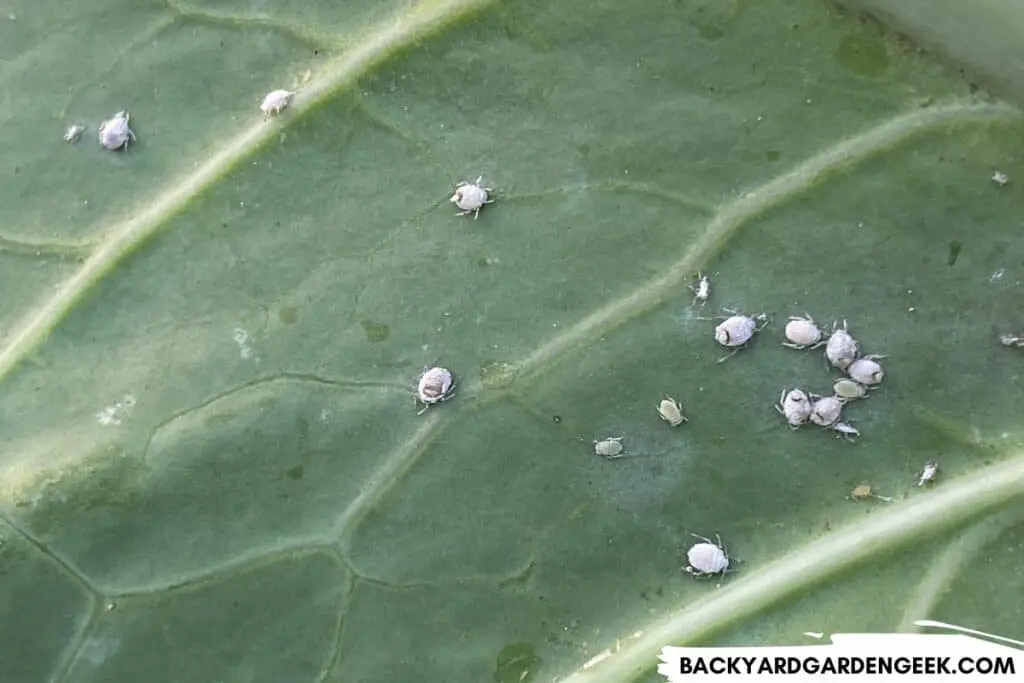
1. Aphids Rob Plants of Vital Nutrients
When aphids attack a plant, they don’t physically damage the plant the way armyworms, cabbage loopers, and other plant-muching bugs do.
Instead, aphids have piercing mouthparts (called stylets) that they use to pierce the plant’s tissue and access its phloem tubes, which carry nutrients throughout the plant.
Once they’ve reached the phloem tubes, aphids begin sucking away those nutrients, depriving the plant of the energy it needs to grow to its full potential.
2. Aphids Spread Plant Diseases
When aphids suck away nutrients, that’s bad enough for the plant, but aphids are also capable of transmitting nearly 300 diseases once they pierce the plant with their stylets.
Here’s what happens:
- An aphid feeds on a plant that’s harboring a virus. In the process, the aphid picks up the virus. This can happen very quickly.
- The aphid harbors the virus as it continues to search for a preferred host plant.
- On a new plant, the aphid pierces the plant’s tissue, transmitting the virus in the process.
The virus transmission process is pretty fascinating from a scientific point of view, but from a gardening perspective, it’s downright horrifying.
If you allow an aphid infestation to linger, you’re not only putting your own plants at risk, but you’re also potentially making things worse for your neighbors as the aphids among your plants might carry diseases beyond the boundaries of your property.
If you’d like to learn more about the different viruses aphids can spread, check out my articles on black, green, red, yellow, and white aphids.
The one bit of good news is that aphids aren’t poisonous, they can’t harm humans, and they can’t spread diseases to pets.
3. Aphids Harm Developing Fruit
When aphids begin feeding on plants, whether those are garden plants (eggplants, peppers, tomatoes, etc.) or fruit trees, these tiny pests will not merely suck away the plant’s nutrients. They’ll also end up damaging the developing fruit.

Here’s why: Aphids love to attach themselves to buds and emerging flowers. This will often result in flower abortion, which is when a flower develops but then falls off without producing any fruit due to the lack of necessary nutrients or insufficient photosynthesis.
In other words, aphids can hinder fruit development entirely if they attack the plant while its flowers are developing.
But aphids can harm fruit even if they don’t completely destroy the flower. By attaching themselves to the flower, then the fruit, they’ll cause growth distortions in developing fruit, which can result in stunted overall growth or fruit that look misshapen or unsightly.
These are still perfectly edible, even if the plant was overrun by aphids. They just need to be washed off properly.
Unfortunately, when aphid harm fruit, they hinder the overall production of your plant, thus decreasing the harvest you would have had if aphids hadn’t shown up.
4. Aphids Destroy Young Seedlings
When it comes to aphid damage, there’s a big difference in the amount of harm aphids can do to seedlings versus fully grown plants.
Last year, I started 7 shishito pepper plants from seed. All of the seedlings were developing properly, but as I began acclimating them to the outdoor environment, aphids struck.
I admittedly wasn’t paying the closest attention to them since everything was growing just fine, but after a few days, I noticed that several plants looked damaged.
Upon a closer inspection, 4 of the 7 plants had aphids on them, and since the seedlings were still so small, the aphids had not only damaged several leaves, but they had also destroyed the main stem.

Following the method I share at the bottom of this article, I got rid of the aphids, but the damage was already done. The 3 shishito seedlings that weren’t damaged continued growing perfectly, but the other 4 were so damaged it wasn’t even worth keeping them. I gave them another month to see if they could recover, but the growth was negligible, so I finally decided to discard the aphid-ridden plants by tossing them in the compost bin.
Fast forward several months, and I fortunately had 3 mature, nice-looking shishito pepper plants. Not surprisingly, another group of aphids arrived later in the summer and made their home among 1 of the plants, leaving sticky honeydew residue all over its leaves.
But unlike the seedlings, this plant weathered the infestation just fine once I got involved. After a few days of spraying it with soapy water and giving it a single dose of neem oil spray, my plant fully recovered from the aphid infestation and continued producing peppers for several more months.
5. Aphids Increase the Risk of Fungal Diseases
Speaking of honeydew droplets, if you happen to see a sheen on your plants’ foliage, then you’ve likely got aphids among your plants.
When aphids feed, they release a sugary byproduct known as honeydew that looks like tiny little droplets sprinkled all over your plants.
These droplets will attract unwanted ants since the latter love to feast on these sugary morsels. But if the honeydew isn’t immediately harvested by ants, it’ll deteriorate and leave a sticky film on your plants.
This is bad news since that stickiness will catch any fungal spores that happen to be floating through the air, giving them a perfect environment for explosive growth.
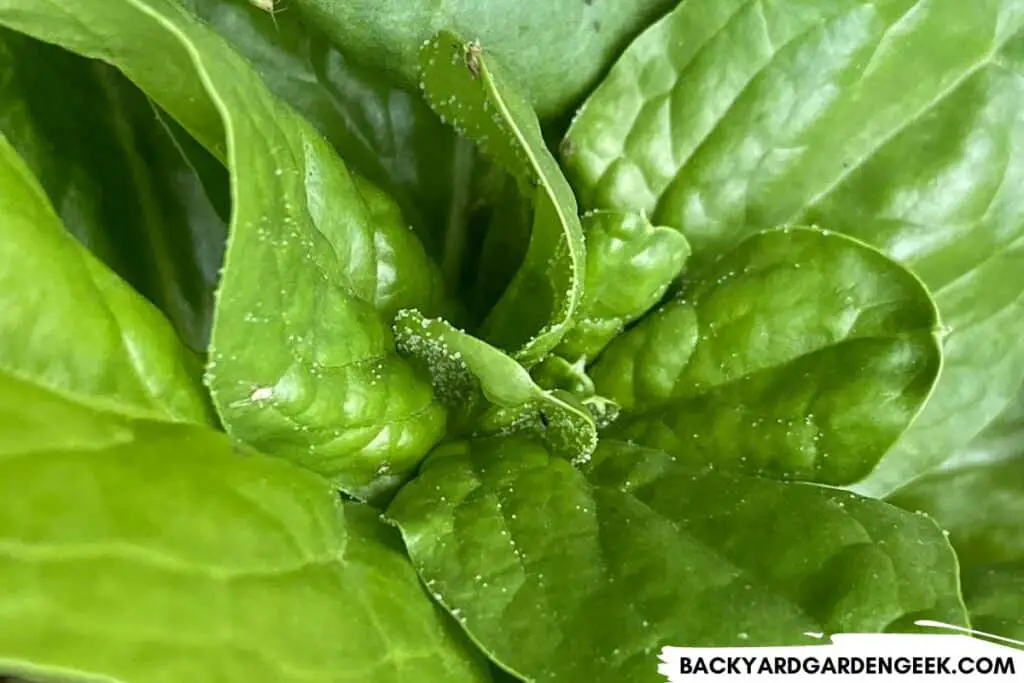
When this happens, you’ll see an increased risk of fungal disease since the plants have no way to keep fungal spores from attaching to their now sticky foliage.
6. Aphids Inject Toxins Into Plants
I haven’t seen as many research studies on the subject of aphids and toxins as I have on aphids as disease vectors, but there’s evidence that suggests that certain aphids can inject toxins into plants as they feed on the plants’ nutrients.
As aphids release toxins into the plants, those toxins can damage leaves, twigs, branches, or fruit, depending on where the aphids happen to be feeding and what aphid species has arrived among your plants.
7. Aphids Cause Galls to Form on Plants
There’s really only one way to know if aphids have injected toxins into your plants: You’ll see distortions in the plant, usually in the form of leaf curl or galls.
This type of damage won’t typically kill off plants, but it’ll often cause leaves to drop off early, branches and stems to break easier, and flowers or buds to grow in distorted ways.
If you notice galls or distorted growth patterns among your plants, shrubs, or trees, you might want to take pictures and contact your local extension office to get an expert opinion.
You should also use the soapy water method that I describe below since it’s an easy, organic way to kill off aphids.
8. Aphids Attract Insect-Killing Ants
As I noted above, ants love honeydew droplets, which means that ants and aphids have a symbiotic relationship. When aphids arrive, ants will often show up soon thereafter.
Not surprisingly, the arrival of ants often makes aphids infestations worse because ants will do their best to protect aphids from all kinds of beneficial predators: lacewing larvae, ladybugs, and parasitic wasps, to name a few.

Ants won’t kill or eat aphids. They mostly won’t pollinate your plants either.
What they’ll do is focus their attention on aphid protection and honeydew harvesting. They’ve even been shown to have preferences for some honeydew over others, so they’ll protect those aphid species that produce the very best kinds of honeydew.
If you see ants among your plants–maybe you’ve noticed lots of specks around your lettuce, okra or pepper plants–you’ll want to act quickly.
But your goal isn’t to kill off the ants. You need to kill off the aphids. Once you do that, the ants will leave your plants and go looking elsewhere for food.
(And thankfully, aphids are easy to spot if you know what you’re looking for.)
9. Aphids Multiply Exponentially
Unfortunately for us gardeners, aphids are adept at reproducing themselves since female aphids will give birth to live aphids once every few days.
In fact, when they’re born, female aphids are already pregnant with the next generation of aphids!
What this means is that aphids will spread quickly from host plant to host plant. They’ll even produce eggs each fall in anticipation of cold weather, which will allow the aphid colony to survive even the harshest winter months.
If you were hoping that freezing weather would kill off any remaining aphids in your garden, think again. Certain aphid species have even adapted to arctic climates, so cold, freezing temperatures are no guarantee that aphids won’t overwinter on your property.
10. Aphids Produce Flying Aphids
Aphids are an invasive pest, and they can travel to your property in various ways: carried in on locally bought plants, hitching a ride on your clothes or skin, or blown in by the wind.
But by far the easiest way for aphids to spread is to fly from one place to another.
When female aphids recognize that the host plant is starting to die or that the colony is growing too large for its local area, they’ll begin producing winged versions of themselves so as to allow the colony to migrate from its current location to a new host plant.
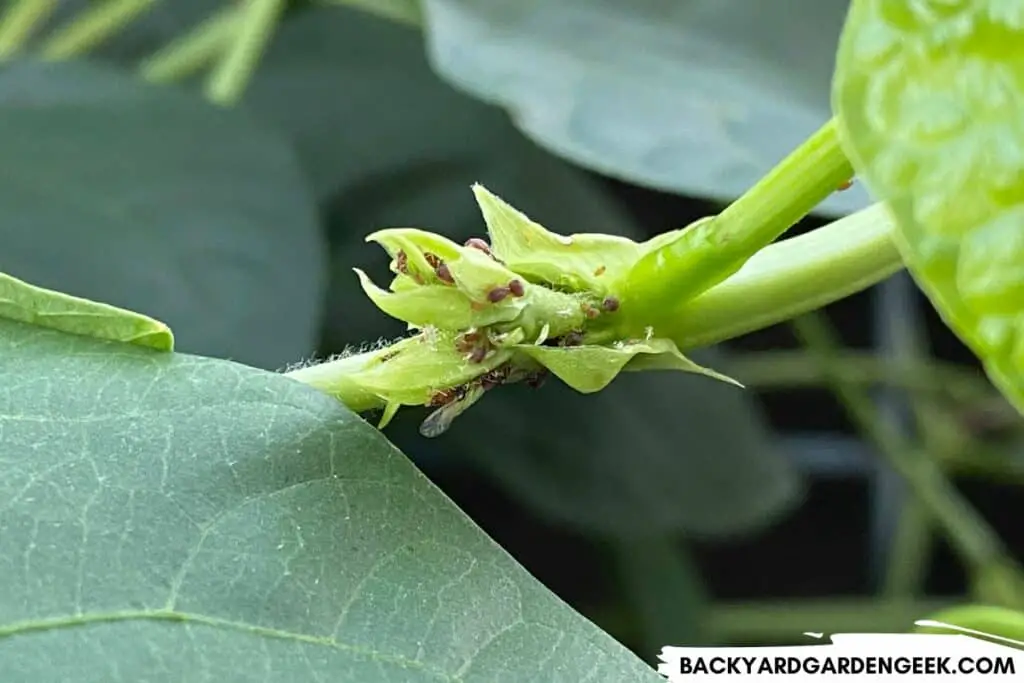
Winged aphids aren’t adept at flying, but they’ll take advantage of wind patterns to hopscotch from one area to another in search of a new host plant. They’ll feed on over 200 plant varieties, but they’ve got some favorites.
Take a look at this list of 21 garden plants that aphids love to get a sense of the plants that aphids feed on most often.
11. Aphids Prepare for Future Infestations
As I noted above, aphids have not only acclimated to various climates. They’re also adept at recognizing the changing of seasons and preparing for the arrival of harsh winter weather.
When female aphids begin noticing a shift from summer to fall, they’ll begin producing male aphids for the sole purpose of reproduction.
Once the males have reached maturity, they’ll mate with the female aphids, which will allow the females to produce eggs.
These eggs are often laid among branches, twigs, and leaves, which provide some protection from the elements. As the weather outside worsens, the developing aphid remains safe and secure in the egg.
Aphids mortality tends to be pretty high during winters (typically around 80-85%), but the 10-15% of aphids that survive the winter are enough to keep the population intact once spring arrives, and they begin reproducing again.
Aphid eggs won’t hurt your plants in any way, but the aphids that emerge from those eggs come spring will begin immediately feeding on your plants. This means that it’s very important to clean up your garden after each growing season so that you keep as many aphids as possible from overwintering among garden debris.
3 Easy Steps to Get Rid of Aphids
Now that you know the many ways that aphids can damage your plants, let’s look at a simple 3-step process I use to get rid of aphids once I notice them in my garden:
Step 1: Blast Aphids with Water
Water alone will not stop most aphid infestations (unless you catch the problem as early as possible), but water can kill off aphids here and there, helping to decrease the overall population.
Just to be clear, rain will not kill off aphids since they’ll just cling to plants during the strongest thunderstorms.
What you’ll need to do instead is to blast your plants with a burst of water from a garden hose.
Please be careful when doing so. If you hit your plants with a jet of water, you might damage them.
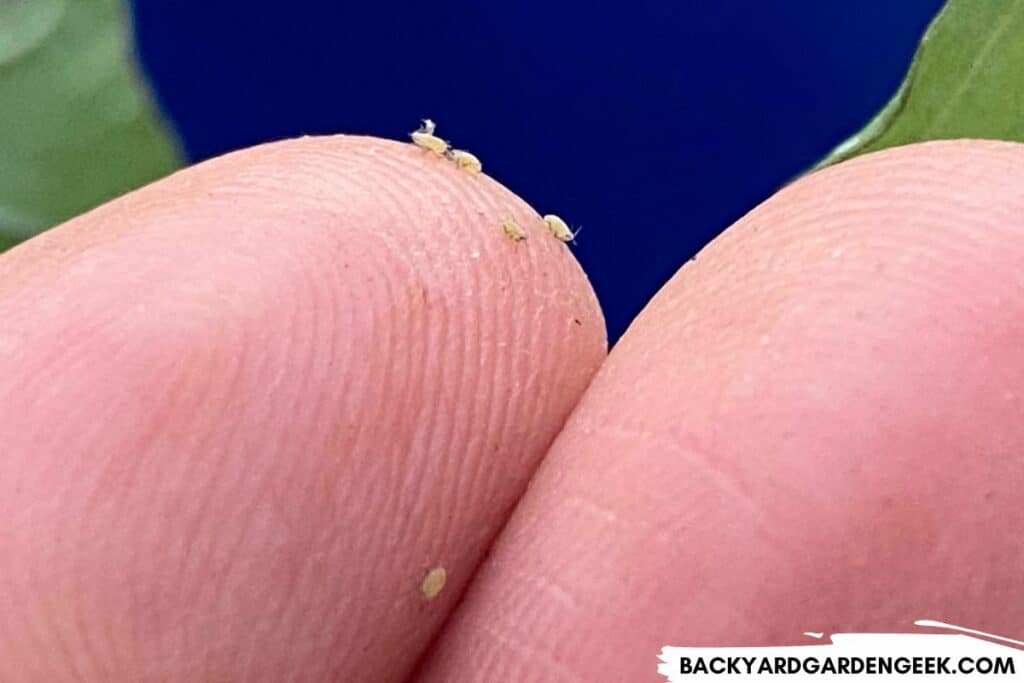
If I notice aphids on my plants, what I do first is to spray them with as much force as I think the plant can tolerate. After doing so, I moved on to Step 2.
Step 2: Spray Your Plants with Soapy Water
- Using a 1- or 2-gallon sprayer (7.5 L), fill it up with water. You should definitely invest in a 2-gallon sprayer since you can mix up 2 gallons’ worth of soapy water, then store whatever you don’t need for use the next day. That beats making a new batch every day or two!
- Once you’ve added your water, pour in 4-5 tablespoons (15-30 ml) of castile liquid soap (15-30 ml) for each gallon of water. Dr. Bronner’s Peppermint Castile Soap is a solid choice and the product I use most often, but you can also purchase good insecticidal soaps, which will work just as well.
- After you’ve added the soap, shake your sprayer for 10-15 seconds to ensure everything gets mixed well. Once you’ve done so, start spraying your plants using either the “mist” or “stream” settings. I like using the “stream” setting for the first day or two since its a more forceful spray. Just make sure to spray underneath all of your leaves since aphids like to hide there.
For best results, spray your plants with soapy water once per day for 5-7 days, preferably in the early evening when the sun is already setting.
That way, you’ll be less likely to burn or damage your plants and also less likely to kill off any pollinating insects that happen to be flying around during the daytime hours.
Step 3: Use a Neem Oil Spray for Lasting Effects
If you want to take your aphid-killing skills to the next level, I recommend substituting a neem oil spray on Day 3 or 4 in lieu of a soapy water spray.
Unlike soapy water, which doesn’t have any lasting effects, neem oil will remain on the plant for a few days and begin killing off any bugs that are feeding during that time.
But neem oil will also take several days to kill bugs, so I recommend continuing to use soapy water in the meantime.
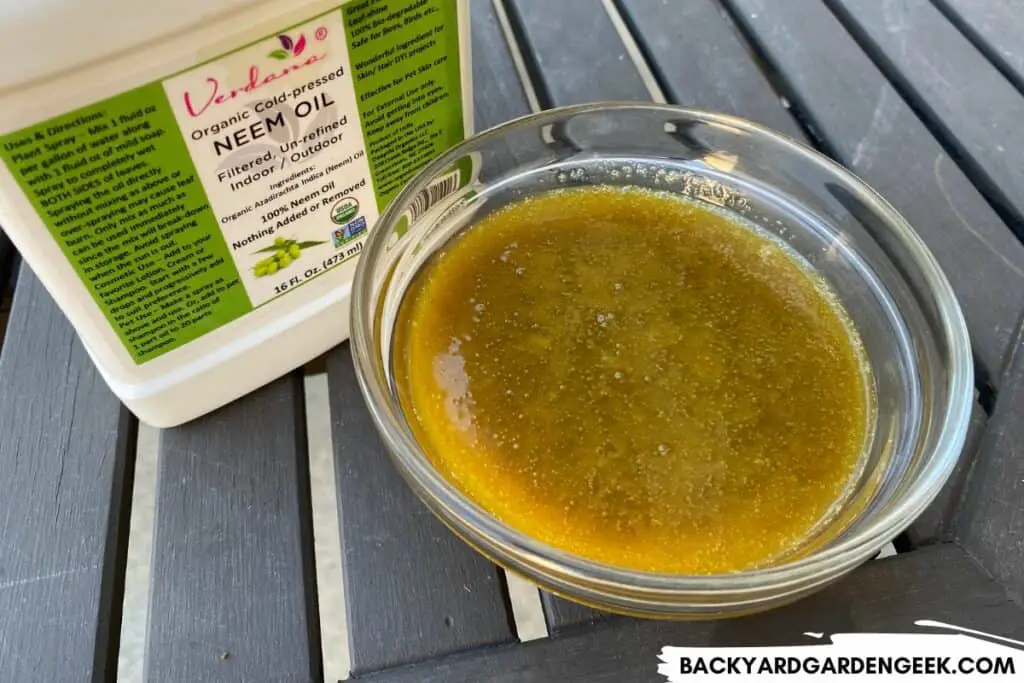
Here’s the formula I use for my neem oil sprays:
- Unless you’ve got a very large garden, I recommend using a 1/2 gallon sprayer (1.9 liters). Neem oil won’t store once it’s mixed, so you need to use up everything.
- After you fill your garden sprayer with water, add 1 tablespoon (15 ml) of neem oil to the sprayer. I prefer these products: Verdana and Neem Bliss.
- Finally, add 2 teaspoons (10 ml) of castile liquid soap to the water and neem oil. This is absolutely necessary since water and neem oil won’t much without a soapy emulsifier. I always use Dr. Bronner’s Peppermint Castile Soap for this sort of thing.
I’ve got a 10-step process for making the best neem oil spray possible, but when it comes to applying neem oil, spray your plants thoroughly, making sure to get the undersides of the leaves.
Most importantly, you must wait until early evening (preferably at sunset) before applying any neem oil spray.
Some people suggest spraying your plants in the early morning, but there’s a good chance your plants will get burned if the neem oil spray doesn’t have time to fully dry before the sun rises, which is why sunset is the best time for application.
If you want to add a neem oil spray to your soapy water schedule, your treatment will look like this for an extreme infestation:
| Day | Treatment Method |
|---|---|
| Day 1 | Soapy Water Spray |
| Day 2 | Soapy Water Spray |
| Day 3 | Neem Oil Spray |
| Day 4 | Soapy Water Spray |
| Day 5 | Soapy Water Spray |
| Day 6 | Soapy Water Spray |
| Day 7 | Soapy Water Spray |
Of course, you might need fewer (or possibly even more) treatment than the schedule outlined here, so please use your best judgment to determine whether or not you’ve taken care of your aphid problem.
Further Reading
If you’re interested in learning more about the best ways to handle aphid infestations, take a look at these related articles:
- 12 Reasons Why Aphids Keep Coming Back + 3 Simple Fixes
- Are Aphids Good or Bad? Everything You Need to Know
- Reusing Aphid-Infested Soil: Should You Do It? Expert Tips
- What Bugs Does Neem Oil Repel and Get Rid Of?
- Why Do Insects Hate Neem Oil? 12 Secrets to Its Success
- Will Neem Oil Kill Pollinators or Other Beneficial Insects?


